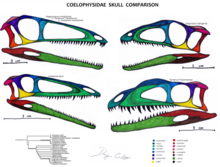Coelophysidae
It has been suggested that this article be merged into Coelophysoidea. (Discuss) Proposed since April 2024. |
| Coelophysids | |
|---|---|

| |
| Skull comparison of Coelophysidae ( "Syntarsus" kayentakatae at the bottom right)
| |
| Scientific classification | |
| Domain: | Eukaryota |
| Kingdom: | Animalia |
| Phylum: | Chordata |
| Clade: | Dinosauria |
| Clade: | Saurischia |
| Clade: | Theropoda |
| Superfamily: | †Coelophysoidea |
| Family: | †Coelophysidae Nopcsa, 1923 |
| Type species | |
| † Coelurus bauri
, 1887 | |
| Genera | |
| Synonyms | |
| |
Coelophysidae is a family of primitive carnivorous
Under
Classification
Characteristics
Coelophysids are characterized by slender, skinny builds and long, narrow skulls with large fenestrae to allow for a lighter skull.[6] They are fairly primitive theropods, and so have fairly basal characteristics, such as hollow air sacs in the cervical vertebrae and obligate bipedalism.[6] Their slender builds allowed them to be fast and agile runners. All known members of Coelophysidae are carnivores. One species, Coelophysis bauri has the oldest known furcula (wishbone) of any dinosaur.[3]
It has also been speculated that some species within Coelophysidae, namely Coelophysis bauri, displayed cannibalism, although the fossil evidence behind these claims has been heavily debated (Rinehart et al., 2009; Gay, 2002; Gay, 2010).[7][8][9]
Phylogenetics
Coelophysidae is part of the larger superfamily of Coelophysoidea, which contains Dilophosauridae, Liliensternus, and Zupaysaurus in addition to Coelophysidae.[2][10][11] Coelophysoidea, in turn, is part of the larger clade of Neotheropoda.[2]
The cladogram below was recovered in a study by Matthew T. Carrano, John R. Hutchinson and Scott D. Sampson, 2005.[12]
| ||||||||||||||||||||||
The cladogram below follows the topology from a 2011 analysis by paleontologists Martin D. Ezcurra and Stephen L. Brusatte, modified with additional data by You Hai-Lu and colleagues in 2014.[1][13]
| |||||||||||||||||||||||||
This cladogram follows the 2017 analysis by Ezcurra,[14] with added results of the Martinez & Apaldetti analysis from their description of Lucianovenator.[15]
| |||||||||||||||||||||||||||||||||||||||||||||||||
Biogeography
Fossils of members of Coelophysidae have been found across many continents, including North America, South America, Europe, Asia, and Africa. Powellvenator podocitus was discovered in Northwestern Argentina.[16] Procompsognathus triassicus was discovered in Germany, and Camposaurus arizonensis is from Arizona in North America.[17][13] No coelophysid fossils were known from Asia until the discovery of Panguraptor lufengensis in 2014 in the Yunnan Province of China.[1] The genus Coelophysis has been found in North America, South Africa, and Zimbabwe.[18]
See also
- Timeline of coelophysoid research
- Coelophysoidea
- Coelophysis bauri
References
- ^ PMID 25544219.
- ^ ISSN 1567-2158.
- ^ .
- ^ Tykoski, Ronald S. (2005). Anatomy, Ontogeny, and Phylogeny of Coelophysoid Theropods (PhD). University of Texas at Austin.
- ^ Sereno, P. (1999). "Taxon Search: Coelophysidae Archived 2007-10-07 at the Wayback Machine". Accessed 2009-09-02.
- ^ PMID 20007898.
- ^ Rinehart, L.F.; Lucas, S.G.; Heckert, A.B.; Spielmann, J.A.; Celesky, M.D. (2009). "The paleobiology of Coelophysis bauri (Cope) from the Upper Triassic (Apachean) Whitaker quarry, New Mexico, with detailed analysis of a single quarry block". New Mexico Museum of Natural History & Science, a division of the Department of Cultural Affairs Bulletin. 45: 260.
- ^ Gay, R.J. (2002). "The myth of cannibalism in Coelophysis bauri". Journal of Vertebrate Paleontology. 22 (3): 57A.
- ISBN 978-0-557-46616-0
- .
- ISSN 0567-7920.
- .
- ^ .
- ISSN0002-7014.
- doi:10.5710/AMGH.09.04.2017.3065.
- ISSN 0002-7014.
- ISSN 0016-6995.
- ^ Bristowe, A.; Raath, M.A. (2004). "A juvenile coelophysoid skull from the Early Jurassic of Zimbabwe, and the synonymy of Coelophysis and Syntarsus". Palaeontologica Africana. 40: 31–41.
